Peugeot 208 2015 Owner's Manual - RHD (UK, Australia)
Manufacturer: PEUGEOT, Model Year: 2015, Model line: 208, Model: Peugeot 208 2015Pages: 341, PDF Size: 38.75 MB
Page 181 of 341
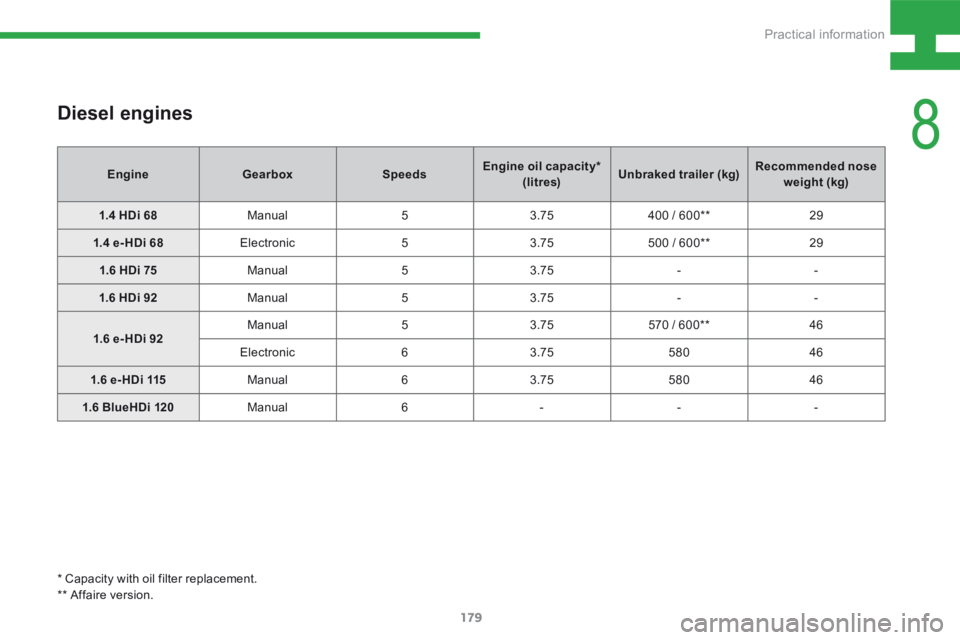
179
208_en_Chap08_Informations-pratiques_ed01-2015
* Capacity with oil filter replacement.
** Affaire version.
Diesel engines
EngineGearbox SpeedsEngine oil capacity*
(litres) Unbraked trailer (kg) Recommended nose
weight (kg)
1.4 HDi 68 Manual 53.75400 / 600** 29
1.4 e- HDi 68 Electronic 53.75500 / 600** 29
1.6 HDi 75 Manual 53.75 --
1.6 HDi 92 Manual 53.75 --
1.6 e- HDi 92 Manual
53.75570 / 600** 46
Electronic 63.75 580 46
1.6 e- HDi 115 Manual63.75 580 46
1.6 BlueHDi 120 Manual6---
8
Practical information
Page 182 of 341
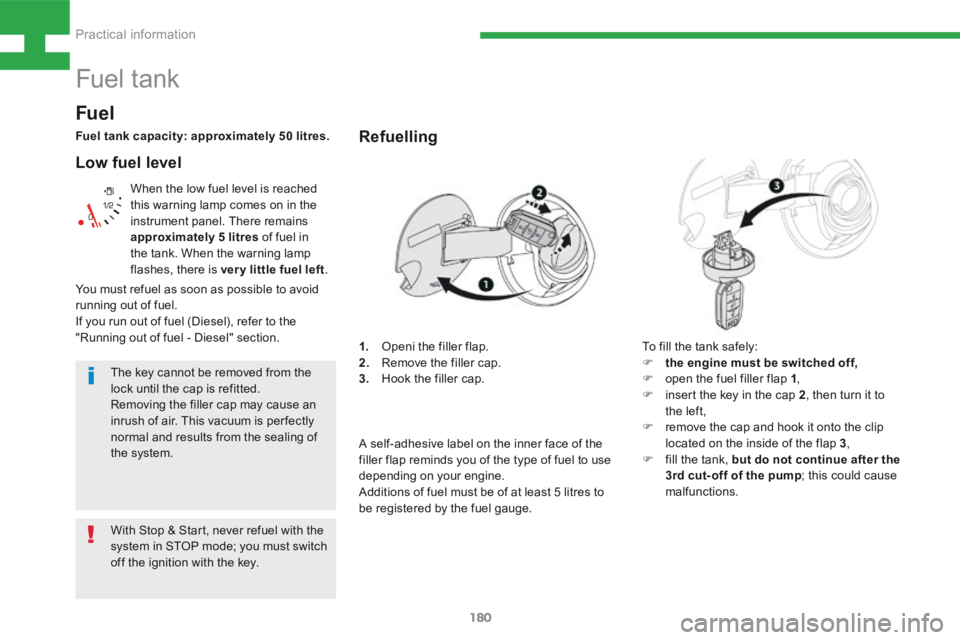
180
208_en_Chap08_Informations-pratiques_ed01-2015
Low fuel level
When the low fuel level is reached
this warning lamp comes on in the
instrument panel. There remains
approximately 5 litres of fuel in
the tank. When the warning lamp
flashes, there is ver y little fuel left .
The key cannot be removed from the
lock until the cap is refitted.
Removing the filler cap may cause an
inrush of air. This vacuum is per fectly
normal and results from the sealing of
the system.
Fuel tank
Fuel
Fuel tank capacity: approximately 50 litres.Refuelling
To fill the tank safely:
F the engine must be switched off,
F open the fuel filler flap 1 ,
F insert the key in the cap 2 , then turn it to
the left,
F remove the cap and hook it onto the clip
located on the inside of the flap 3 ,
F fill the tank, but do not continue after the
3rd cut- off of the pump ; this could cause
malfunctions.
With Stop & Start, never refuel with the
system in STOP mode; you must switch
off the ignition with the key.
You must refuel as soon as possible to avoid
running out of fuel.
If you run out of fuel (Diesel), refer to the
"Running out of fuel - Diesel" section.
A self-adhesive label on the inner face of the
filler flap reminds you of the type of fuel to use
depending on your engine.
Additions of fuel must be of at least 5 litres to
be registered by the fuel gauge.
1.
Openi the filler flap.
2. Remove the filler cap.
3. Hook the filler cap.
Practical information
Page 183 of 341
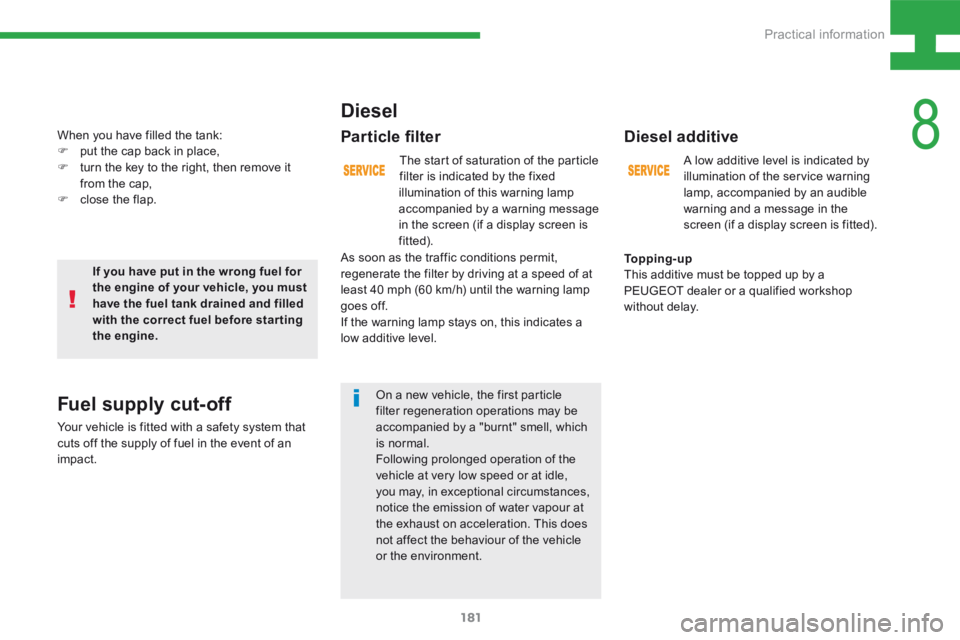
181
208_en_Chap08_Informations-pratiques_ed01-2015
If you have put in the wrong fuel for
the engine of your vehicle, you must
have the fuel tank drained and filled
with the correct fuel before star ting
the engine.
When you have filled the tank:
F
put the cap back in place,
F turn the key to the right, then remove it
from the cap,
F close the flap.
Diesel
The start of saturation of the particle
filter is indicated by the fixed
illumination of this warning lamp
accompanied by a warning message
in the screen (if a display screen is
fitted).
On a new vehicle, the first particle
filter regeneration operations may be
accompanied by a "burnt" smell, which
is normal.
Following prolonged operation of the
vehicle at very low speed or at idle,
you may, in exceptional circumstances,
notice the emission of water vapour at
the exhaust on acceleration. This does
not affect the behaviour of the vehicle
or the environment.
As soon as the traffic conditions permit,
regenerate the filter by driving at a speed of at
least 40 mph (60 km/h) until the warning lamp
goes off.
If the warning lamp stays on, this indicates a
low additive level.
To p p i n g - u p
This additive must be topped up by a
PEUGEOT dealer or a qualified workshop
without delay.
Diesel additive
A low additive level is indicated by
illumination of the service warning
lamp, accompanied by an audible
warning and a message in the
screen (if a display screen is fitted).
Fuel supply cut-off
Your vehicle is fitted with a safety system that
cuts off the supply of fuel in the event of an
impact.
Particle filter
8
Practical information
Page 184 of 341
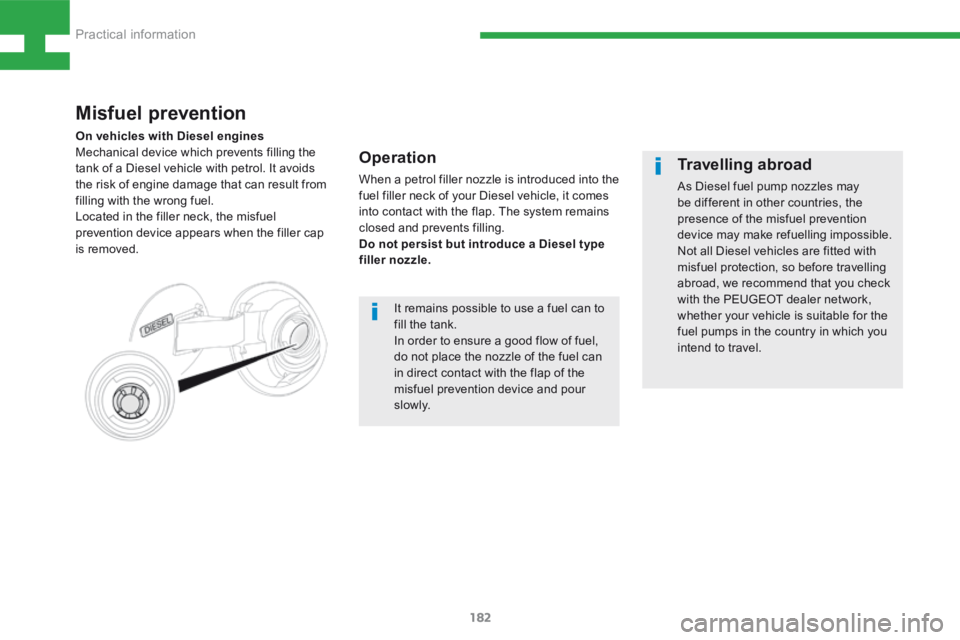
182
208_en_Chap08_Informations-pratiques_ed01-2015
Operation
When a petrol filler nozzle is introduced into the
fuel filler neck of your Diesel vehicle, it comes
into contact with the flap. The system remains
closed and prevents filling.
Do not persist but introduce a Diesel type
filler nozzle.
Misfuel prevention
On vehicles with Diesel engines
Mechanical device which prevents filling the
tank of a Diesel vehicle with petrol. It avoids
the risk of engine damage that can result from
filling with the wrong fuel.
Located in the filler neck, the misfuel
prevention device appears when the filler cap
is removed.It remains possible to use a fuel can to
fill the tank.
In order to ensure a good flow of fuel,
do not place the nozzle of the fuel can
in direct contact with the flap of the
misfuel prevention device and pour
s l ow l y.
Travelling abroad
As Diesel fuel pump nozzles may
be different in other countries, the
presence of the misfuel prevention
device may make refuelling impossible.
Not all Diesel vehicles are fitted with
misfuel protection, so before travelling
abroad, we recommend that you check
with the PEUGEOT dealer network,
whether your vehicle is suitable for the
fuel pumps in the country in which you
intend to travel.
Practical information
Page 185 of 341
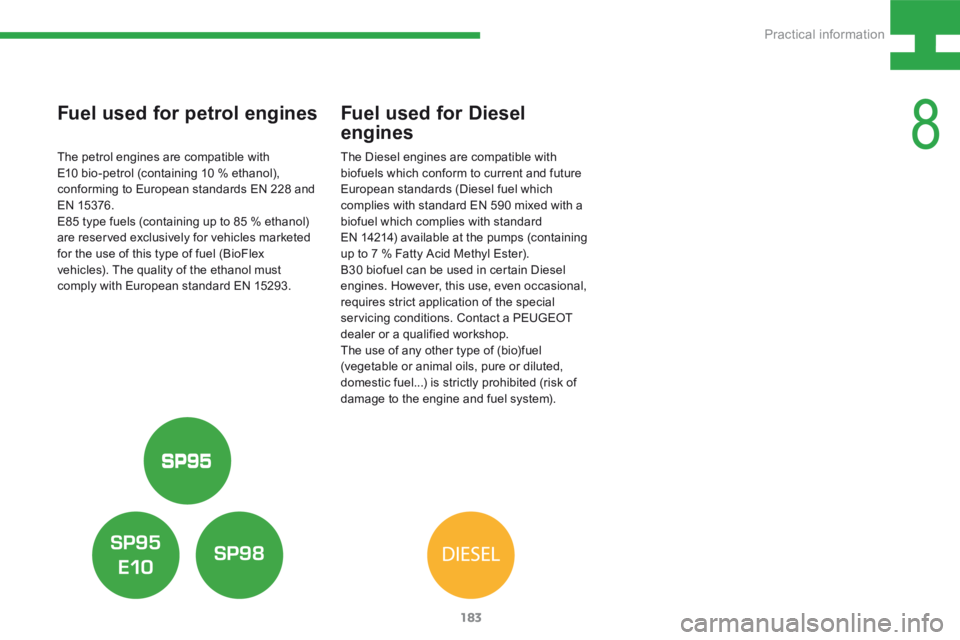
183
208_en_Chap08_Informations-pratiques_ed01-2015
Fuel used for petrol engines
The petrol engines are compatible with
E10 bio-petrol (containing 10 % ethanol),
conforming to European standards EN 228 and
EN 15376.
E85 type fuels (containing up to 85 % ethanol)
are reserved exclusively for vehicles marketed
for the use of this type of fuel (BioFlex
vehicles). The quality of the ethanol must
comply with European standard EN 15293.
Fuel used for Diesel
engines
The Diesel engines are compatible with
biofuels which conform to current and future
European standards (Diesel fuel which
complies with standard EN 590 mixed with a
biofuel which complies with standard
EN 14214) available at the pumps (containing
up to 7 % Fatty Acid Methyl Ester).
B30 biofuel can be used in certain Diesel
engines. However, this use, even occasional,
requires strict application of the special
servicing conditions. Contact a PEUGEOT
dealer or a qualified workshop.
The use of any other type of (bio)fuel
(vegetable or animal oils, pure or diluted,
domestic fuel...) is strictly prohibited (risk of
damage to the engine and fuel system).
8
Practical information
Page 186 of 341
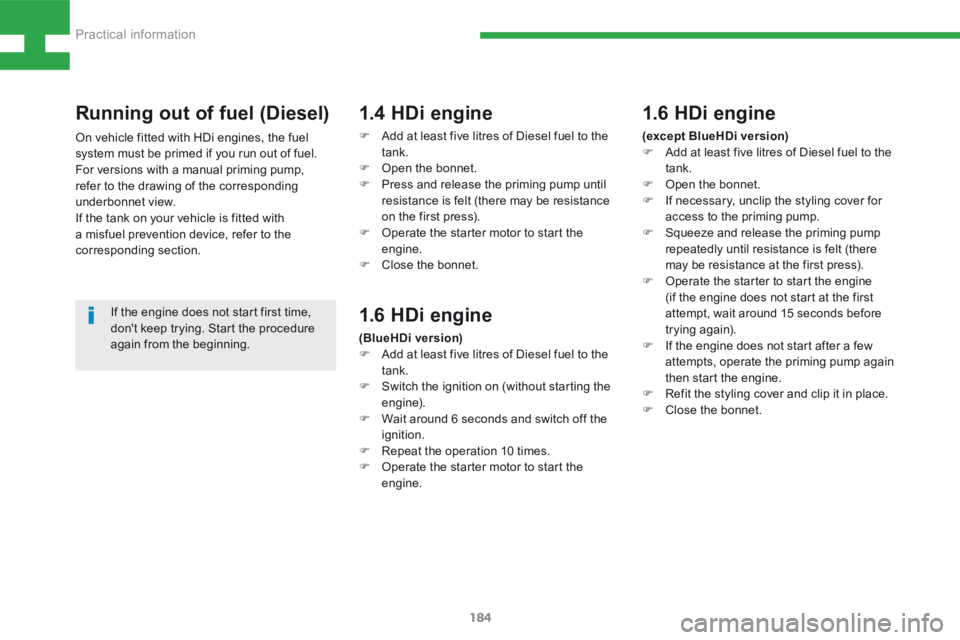
184
208_en_Chap08_Informations-pratiques_ed01-2015
On vehicle fitted with HDi engines, the fuel
system must be primed if you run out of fuel.
For versions with a manual priming pump,
refer to the drawing of the corresponding
underbonnet view.
If the tank on your vehicle is fitted with
a misfuel prevention device, refer to the
corresponding section.
Running out of fuel (Diesel)
If the engine does not start first time,
don't keep trying. Start the procedure
again from the beginning.
1.4 HDi engine
F Add at least five litres of Diesel fuel to the
tank.
F Open the bonnet.
F Press and release the priming pump until
resistance is felt (there may be resistance
on the first press).
F Operate the starter motor to start the
engine.
F Close the bonnet.
1.6 HDi engine
(except BlueHDi version)
F Add at least five litres of Diesel fuel to the
tank.
F Open the bonnet.
F If necessary, unclip the styling cover for
access to the priming pump.
F Squeeze and release the priming pump
repeatedly until resistance is felt (there
may be resistance at the first press).
F Operate the starter to start the engine
(if the engine does not start at the first
attempt, wait around 15 seconds before
trying again).
F If the engine does not start after a few
attempts, operate the priming pump again
then start the engine.
F Refit the styling cover and clip it in place.
F Close the bonnet.
1.6 HDi engine
(BlueHDi version)
F Add at least five litres of Diesel fuel to the
tank.
F Switch the ignition on (without starting the
engine).
F Wait around 6 seconds and switch off the
ignition.
F Repeat the operation 10 times.
F Operate the starter motor to start the
engine.
Practical information
Page 187 of 341
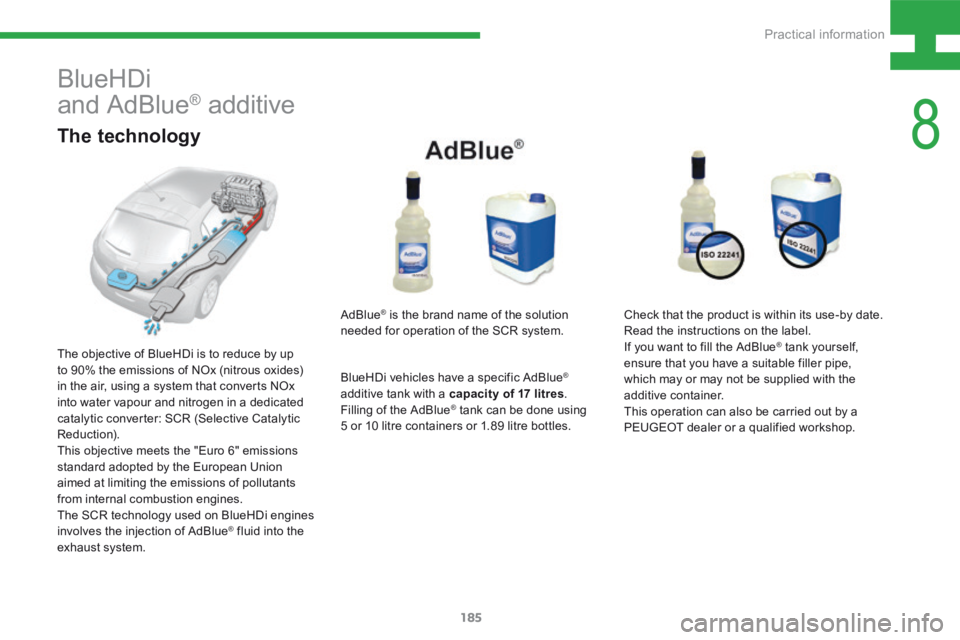
185
208_en_Chap08_Informations-pratiques_ed01-2015
BlueHDi
and AdBlue
® additive
The technology
AdBlue® is the brand name of the solution
needed for operation of the SCR system.
BlueHDi vehicles have a specific AdBlue
®
additive tank with a capacity of 17 litres .
Filling of the AdBlue
® tank can be done using
5 or 10 litre containers or 1.89 litre bottles.
The objective of BlueHDi is to reduce by up
to 90% the emissions of NOx (nitrous oxides)
in the air, using a system that converts NOx
into water vapour and nitrogen in a dedicated
catalytic converter: SCR (Selective Catalytic
Reduction).
This objective meets the "Euro 6" emissions
standard adopted by the European Union
aimed at limiting the emissions of pollutants
from internal combustion engines.
The SCR technology used on BlueHDi engines
involves the injection of AdBlue
® fluid into the
exhaust system. Check that the product is within its use-by date.
Read the instructions on the label.
If you want to fill the AdBlue
® tank yourself,
ensure that you have a suitable filler pipe,
which may or may not be supplied with the
additive container.
This operation can also be carried out by a
PEUGEOT dealer or a qualified workshop.
8
Practical information
Page 188 of 341
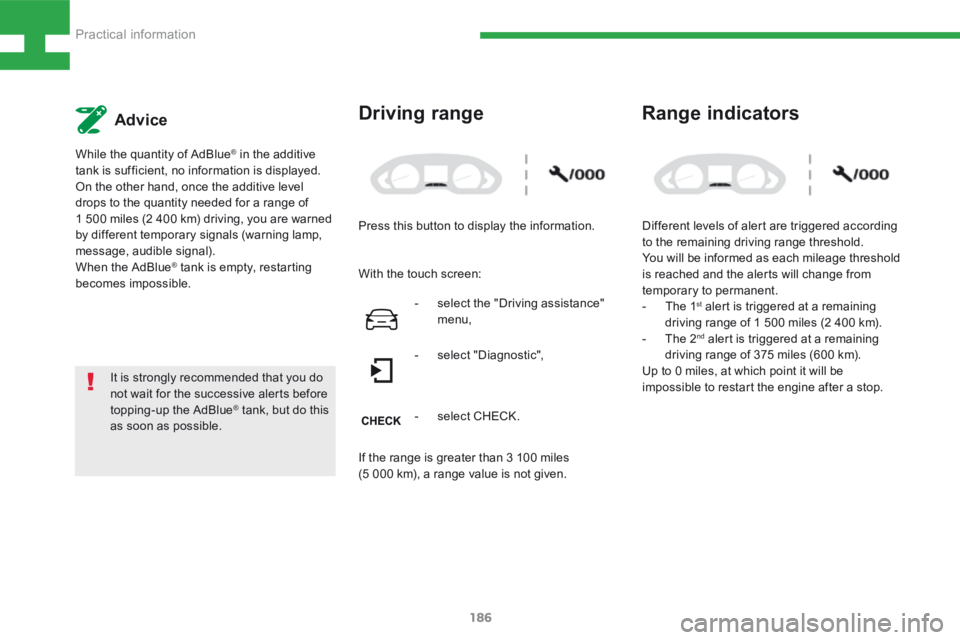
186
208_en_Chap08_Informations-pratiques_ed01-2015
Advice
While the quantity of AdBlue® in the additive
tank is sufficient, no information is displayed.
On the other hand, once the additive level
drops to the quantity needed for a range of
1 500 miles (2 400 km) driving, you are warned
by different temporary signals (warning lamp,
message, audible signal).
When the AdBlue
® tank is empty, restarting
becomes impossible. Different levels of alert are triggered according
to the remaining driving range threshold.
You will be informed as each mileage threshold
is reached and the alerts will change from
temporary to permanent.
-
The 1
st alert is triggered at a remaining
driving range of 1 500 miles (2 400 km).
- The 2
nd alert is triggered at a remaining
driving range of 375 miles (600 km).
Up to 0 miles, at which point it will be
impossible to restart the engine after a stop.
Range indicators
It is strongly recommended that you do
not wait for the successive alerts before
topping-up the AdBlue
® tank, but do this
as soon as possible.
Driving range
Press this button to display the information.
With the touch screen:
If the range is greater than 3 100 miles
(5 000 km), a range value is not given. -
select the "Driving assistance"
menu,
- select "Diagnostic",
- select CHECK.
Practical information
Page 189 of 341
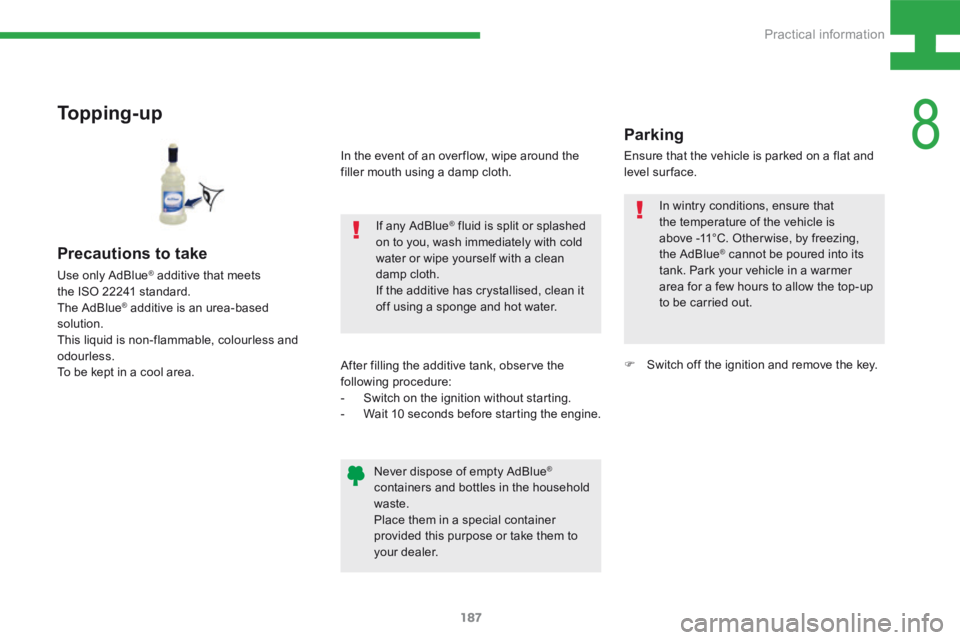
187
208_en_Chap08_Informations-pratiques_ed01-2015
To p p i n g - u p
If any AdBlue® fluid is split or splashed
on to you, wash immediately with cold
water or wipe yourself with a clean
damp cloth.
If the additive has crystallised, clean it
off using a sponge and hot water.
Precautions to take
Use only AdBlue® additive that meets
the ISO 22241 standard.
The AdBlue
® additive is an urea-based
solution.
This liquid is non-flammable, colourless and
odourless.
To be kept in a cool area. After filling the additive tank, observe the
following procedure:
-
Switch on the ignition without starting.
- Wait 10 seconds before starting the engine.
Never dispose of empty AdBlue
®
containers and bottles in the household
waste.
Place them in a special container
provided this purpose or take them to
your dealer. Ensure that the vehicle is parked on a flat and
level surface.
Parking
F
Switch off the ignition and remove the key.
In the event of an over flow, wipe around the
filler mouth using a damp cloth.
In wintry conditions, ensure that
the temperature of the vehicle is
above -11°C. Other wise, by freezing,
the AdBlue
® cannot be poured into its
tank. Park your vehicle in a warmer
area for a few hours to allow the top-up
to be carried out.
8
Practical information
Page 190 of 341
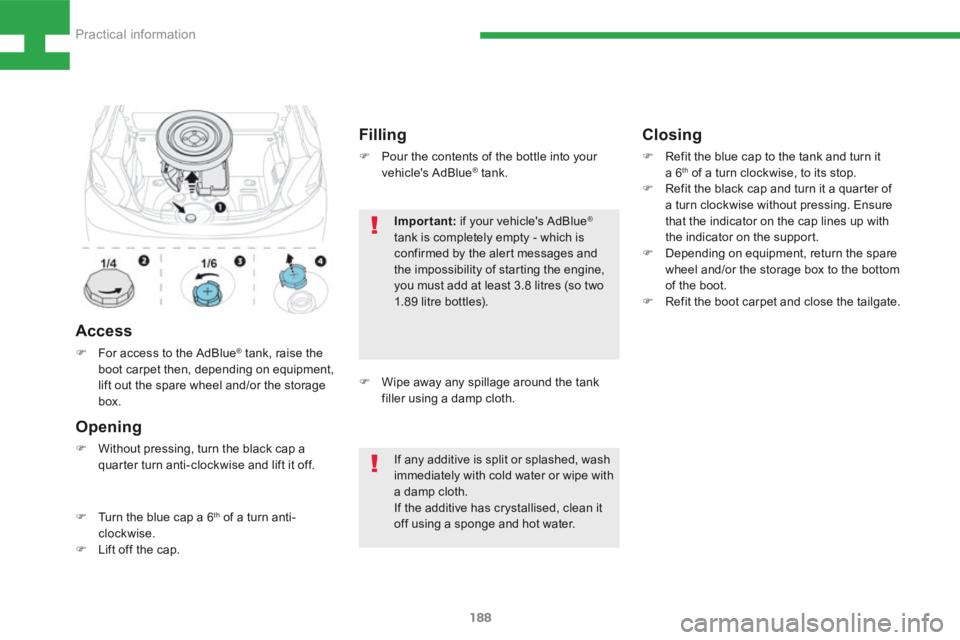
188
208_en_Chap08_Informations-pratiques_ed01-2015
Filling
F Pour the contents of the bottle into your
vehicle's AdBlue® tank.
Important : if your vehicle's AdBlue
®
tank is completely empty - which is
confirmed by the alert messages and
the impossibility of starting the engine,
you must add at least 3.8 litres (so two
1.89 litre bottles).
If any additive is split or splashed, wash
immediately with cold water or wipe with
a damp cloth.
If the additive has crystallised, clean it
off using a sponge and hot water.
F
Wipe away any spillage around the tank
filler using a damp cloth.
Closing
F Refit the blue cap to the tank and turn it
a 6th of a turn clockwise, to its stop.
F Refit the black cap and turn it a quarter of
a turn clockwise without pressing. Ensure
that the indicator on the cap lines up with
the indicator on the support.
F Depending on equipment, return the spare
wheel and/or the storage box to the bottom
of the boot.
F Refit the boot carpet and close the tailgate.
Access
F For access to the AdBlue® tank, raise the
boot carpet then, depending on equipment,
lift out the spare wheel and/or the storage
box.
Opening
F Without pressing, turn the black cap a
quarter turn anti-clockwise and lift it off.
F Turn the blue cap a 6
th of a turn anti-
clockwise.
F Lift off the cap.
Practical information